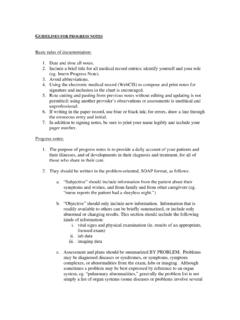Transcription of GENERAL PHYSICAL EXAMINATION
1 BLSA Operations Manual Volume I Section IV, page 1 GENERAL PHYSICAL EXAMINATION 1. Background and Rationale The PHYSICAL EXAMINATION is an important component of translational research. It yields noninvasive, inexpensive and informative data that contributes to clinically relevant diagnoses, prognosis, and assessment of risk. In addition, the PHYSICAL EXAMINATION is important to participants and promotes recruitment and retention in the study. Objective The objectives of the PHYSICAL EXAMINATION are: 1) To document PHYSICAL findings in the cardiovascular, musculoskeletal and nervous systems that are related to mobility in older adults 2) To screen participants for testing exclusion criteria to allow safe and meaningful completion of performance testing Recommended Instrument(s) Strengths and weaknesses of selected approach The strengths of the PHYSICAL EXAMINATION include ease of performance, non-invasive nature ( low risk), and direct contact with participants.
2 The weakness of the PHYSICAL EXAMINATION , in GENERAL , is related to the potential variation in assessment measures and the level of expertise of examiners, the lack of standardized assessment methods for research, and the subjective nature. These effects can be limited by implementing standardized protocols using published techniques when available, utilizing experienced nurse practitioners (NPs) and physicians, training the examiners in standardized fashion, and incorporating ongoing quality control programs that include direct observation and certification. Analagous (past) measures used in the BLSA This is the first version of a fully standardized PHYSICAL EXAMINATION protocol that has undergone rigorous training, certification processes, monitoring and quality control checks.
3 Reliability/Validity Studies Limited studies are available on performing the PHYSICAL EXAMINATION for Version BLSA Operations Manual Volume I Section IV, page 2 research purposes. Where studies are lacking, we chose to use techniques published in standard textbooks or that were used in other studies (InCHIANTI, OAI, Health ABC). Some sections include more detailed descriptions in this protocol to reduce inter-examiner variability in the exam, while other sections have reduced or eliminated measures shown to be of limited use for research purposes and/or to the participants. For example, we limited the previously detailed exam for auscultation of heart murmurs since this has no advantage over the echocardiogram, which is now performed on all subjects.
4 However, the cardiac exam is important to participants, and is used to evaluate participants for medical fitness to undergo cardiac testing and therefore remains in the exam. Jugular venous distension There are standardized ways to examine and report PHYSICAL findings of jugular venous distension (JVD), peripheral arterial disease, (presented in the ABI protocol) and venous stasis. In addition to textbooks used to teach proper PHYSICAL EXAMINATION techniques, Cook and Simel1 published a description of a standardized assessment of jugular venous pressure (JVP), and therefore, central venous pressure. We use this technique of assessing jugular venous pressure to record the presence or absence of JVD in the BLSA participants.
5 The PHYSICAL exam is known to be inferior to the gold standard of central venous monitoring. For example, in three studies, when the clinical assessment of JVP was reported as low, normal or high, the overall pooled accuracy was 56%.1 One of these three studies reported correlation coefficients between assessments of CVP by PHYSICAL EXAMINATION and by central venous monitoring. The range of the correlation coefficients was Another study reported sensitivities of and specificities of The third study reported that physicians correctly predicted CVP 55% of the time. Fortunately, some of the suggested problems in assessing JVP are remediable and are related, in part, to variations in positioning of patients, poor lighting, difficulty distinguishing venous from arterial pulsations, biologic variation related to respiration, and the effects of vasoactive medications and diuretics.
6 In addition, some of the studies included mechanically ventilated patients, in which CVP assessment is more difficult, even for very experienced physicians. Recommendations are available for improving accuracy of JVP assessment in a standardized manner and are incorporated into the protocol outlined in this manual. When the participant is positioned at 45 , JVP that is visible above the clavicle must have a JVP of at least 7 cm, or a CVP of at least 12 cm H20. This is considered the high range of normal for JVP. Although there is debate about the absolute cutoff for abnormal JVP, 9 cm is considered the upper limit of normal by leading cardiovascular Version BLSA Operations Manual Volume I Section IV, page 3 Chronic venous stasis Assessment of chronic venous stasis has always been a subjective measure.
7 The first attempt to standardize the assessment was reported via a consensus statement published in A subsequent publication provided suggestions to define clinical manifestations that had remained subjective due to lack of clear definitions, and thus were known to have low interobserver reproducibility (47%).3 Therefore, the protocol in this manual of operations adopts the recommendations for classifying chronic venous insufficiency as proposed in the consensus statement, with definitions adopted from those proposed by Allegra et al3 in 2003. Studies on the reliability/validity of the recommendations with the recent definitions in place have not yet been published, but these definitions provide a standardized way to implement the widely accepted classification system published in the consensus statement.
8 Key Variables (All missing codes are 555, 666, 777, 888, 999) Total number of teeth Non-removable teeth in contact Oral prosthesis Mucosal inflammation score Plaque score for teeth and dentures Hearing aid Cranial nerves IX-X, oropharynx asymmetry Cranial nerves III, IV, VI: Vertical ocular movement asymmetry Horizontal ocular movement asymmetry Wavy ocular tracking asymmetry Nystagmus Convergence Heart murmurs Version BLSA Operations Manual Volume I Section IV, page 4 Heart rhythm Carotid bruit Pacemaker or ICD present Rales Wheezing Prolonged expiratory phase Dysmetria or frenage , right hand Dysmetria or frenage , left hand Rapidly alternating movements (RAM) rhythmic Number of hand strikes (RAM)
9 Completed in 20 seconds Muscle tone resistance Carpal tunnel Tinel s sign Hoffman sign Palmomental sign Glabellar sign Snout sign Patellar reflex, right Patellar reflex, left Quadriceps tendonitis, right knee Quadriceps tendonitis, left knee Right hip passive internal ROM Version BLSA Operations Manual Volume I Section IV, page 5 Pain with right hip passive internal ROM Left hip passive internal ROM Pain with left hip passive internal ROM JVD present at 45 Abdominojugular reflux Right ankle maximum dorsiflexion Pain with right ankle maximum dorsiflexion Right ankle maximum plantarflexion Pain with right ankle maximum plantarflexion Left ankle maximum dorsiflexion Pain with left ankle maximum dorsiflexion Left ankle maximum plantarflexion Pain with left ankle maximum plantarflexion Right knee crepitus Pain with right knee passive ROM Right knee maximum flexion ROM Right knee painful maximum flexion Right knee maximum extension Right knee effusion Right knee tibiofemoral tenderness Right knee patellar
10 Grind sign Right straight leg ROM Version BLSA Operations Manual Volume I Section IV, page 6 Right straight leg raise painful? Left knee crepitus Pain with Left knee passive ROM Left knee maximum flexion ROM Left knee painful maximum flexion Left knee maximum extension Left knee effusion Left knee tibiofemoral tenderness Left knee patellar grind sign Left straight leg ROM Left straight leg raise painful? Unable to place hand beneath arched back Right biceps reflex Left biceps reflex Graphestesia: Identifies line drawn on sole Identifies circle drawn on sole Identifies + sign drawn on sole Babinski sign Stereognosis: Identifies a quarter in hand Identifies a safety pin in hand Version BLSA Operations Manual Volume I Section IV, page 7 Identifies a dime in hand Identifies a key in hand Time (seconds) to complete 10 heel to shin movements were on right Dysrhythmic heel to shin movements on right Time (seconds)


